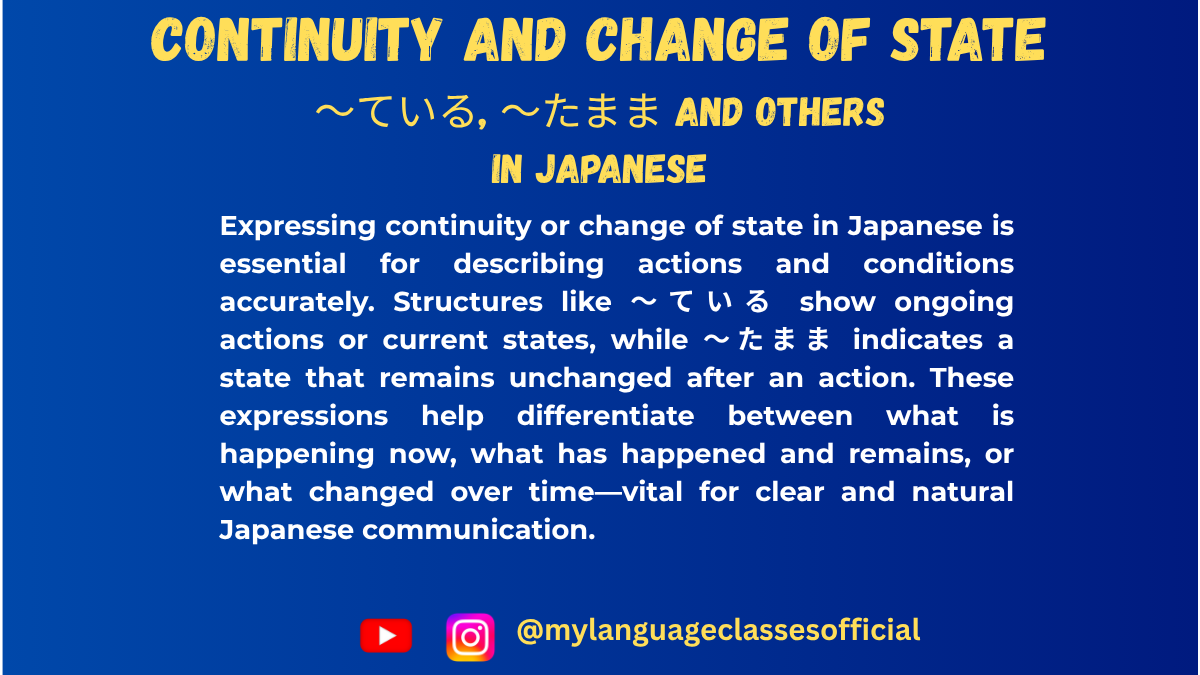Your cart is currently empty!
Tag: ~ながら simultaneous actions
-

How to Show Continuity in Japanese | My Language Classes
Expressing Continuity or Change of State in Japanese
In Japanese, understanding how to express ongoing actions, states, or transitions is essential for achieving fluency. These expressions allow speakers to describe actions in progress, habitual actions, or states resulting from actions. In this blog, we’ll dive into various patterns to express continuity or a change of state, starting with the well-known Verb て-form + いる, and expanding into other structures and nuances.
1. Verb て-form + いる (~ている)
Usage:
- Continuous Action: Indicates an action currently in progress.
- Example:
- 本を読んでいる。
(Hon o yonde iru.)
“I am reading a book.”
- 本を読んでいる。
- Example:
- Resultant State: Refers to the state resulting from an action.
- Example:
- ドアが開いている。
(Doa ga aite iru.)
“The door is open.” (The action of opening has occurred, and the state is ongoing.)
- ドアが開いている。
- Example:
- Habitual Action: Expresses something done regularly or habitually.
- Example:
- 毎朝ジョギングをしている。
(Maiasa jogingu o shite iru.)
“I jog every morning.”
- 毎朝ジョギングをしている。
- Example:
Points to Keep in Mind:
- The context determines whether it refers to an ongoing action, a resultant state, or a habitual action.
- In casual speech, いる is often contracted to る or omitted entirely. For example:
- 読んでる instead of 読んでいる.
2. Verb Stem + 続ける (~つづける)
This pattern expresses the idea of continuing an action without stopping.
Usage:
- Continuous Action: Indicates persistence or continuity of an action.
- Example:
- 彼は勉強し続ける。
(Kare wa benkyou shi tsuzukeru.)
“He continues to study.”
- 彼は勉強し続ける。
- Example:
Points to Keep in Mind:
- The verb 続ける (to continue) can also be conjugated, e.g., 続けます (formal), 続けた (past tense).
- This structure emphasizes effort or intention behind continuity.
3. Verb た-form + まま
This structure expresses the idea of a state being left unchanged.
Usage:
- Unchanged State: Indicates that something remains in its current state.
- Example:
- 靴を履いたまま部屋に入らないでください。
(Kutsu o haita mama heya ni hairanaide kudasai.)
“Please don’t enter the room with your shoes on.”
- 靴を履いたまま部屋に入らないでください。
- Example:
Points to Keep in Mind:
- The subject must remain in the state expressed by the verb.
- Often used to highlight an undesirable or unintended state.
4. Noun + のまま
Similar to the verb usage, this pattern expresses an unchanged state with nouns.
Usage:
- Unchanged State: Describes a situation where something stays the same.
- Example:
- 冷たい飲み物のまま飲んだ。
(Tsumetai nomimono no mama nonda.)
“I drank it while it was still cold.”
- 冷たい飲み物のまま飲んだ。
- Example:
5. Verb Base + ながら
The ~ながら form allows for the expression of two simultaneous actions.
Usage:
- Simultaneous Actions: Describes doing one action while performing another.
- Example:
- 音楽を聴きながら勉強する。
(Ongaku o kikinagara benkyou suru.)
“I study while listening to music.”
- 音楽を聴きながら勉強する。
- Example:
Points to Keep in Mind:
- The main focus is usually on the action described by the main clause.
- Both actions must involve the same subject.
6. Adjective + まま
Describes a state where something remains as it is, often with adjectives.
Usage:
- Unchanged Condition:
- Example:
- 暑いままで寝てしまった。
(Atsui mama de nete shimatta.)
“I fell asleep while it was still hot.”
- 暑いままで寝てしまった。
- Example:
7. Verb て-form + いく / Verb て-form + くる
These forms express a change of state over time or movement.
Usage:
- ~ていく: Indicates a progression away from the present or current state.
- Example:
- 暗くなっていく。
(Kuraku natte iku.)
“It’s getting darker.”
- 暗くなっていく。
- Example:
- ~てくる: Indicates a progression towards the present or a return to the current state.
- Example:
- 涼しくなってきた。
(Suzushiku natte kita.)
“It has started to become cool.”
- 涼しくなってきた。
- Example:
Points to Keep in Mind:
- These forms are particularly useful for describing gradual or dynamic changes.
8. Verb Stem + 出す / Verb Stem + 始める
Both patterns describe the initiation of an action or state.
Usage:
- ~出す: Indicates a sudden or spontaneous beginning of an action.
- Example:
- 赤ちゃんが泣き出した。
(Akachan ga nakidashita.)
“The baby started crying.”
- 赤ちゃんが泣き出した。
- Example:
- ~始める: Describes the commencement of an action.
- Example:
- 本を読み始める。
(Hon o yomihajimeru.)
“I start reading a book.”
- 本を読み始める。
- Example:
Points to Keep in Mind:
- 出す suggests a more abrupt or unexpected start, while 始める implies a deliberate beginning.
Final Thoughts:
When discussing continuity or a change of state in Japanese, understanding the nuances of these patterns is crucial. The choice of expression depends on context, intent, and the subtleties of the situation being described. Here are some key points to remember:
- Context is king: Be mindful of whether you’re describing an ongoing action, a habitual action, or a resultant state.
- Nuance matters: Patterns like ~ていく and ~てくる convey subtle differences in directionality or emotional tone.
- Practice in context: Try creating sentences using each pattern to internalize their meanings and usage.
By mastering these structures, you can convey complex temporal and state-related concepts in Japanese with clarity and precision. Happy learning! 😊
If you enjoyed this lesson, be sure to check out more posts like this on my blog at My Language Classes. Don’t forget to subscribe my YouTube channel and follow me on Instagram for the latest language learning tips and lessons. Leave a comment below to share your thoughts, or ask any questions you have about nouns.
Happy learning! 😊
- Continuous Action: Indicates an action currently in progress.
